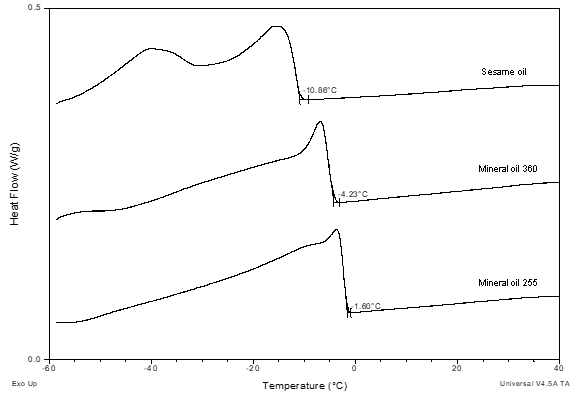Comparative study of the thermal properties of Sesame oil and two mineral oils of different viscosity
DOI:
https://doi.org/10.17981/ingecuc.15.2.2019.10Keywords:
mineral oil, pour point, melting temperature, thermal stability, oxidative stability, DSC, sesame oilAbstract
Introduction: In recent years the research and development of biolubricants from vegetable oils has increased to minimize the impact on the environment of petroleum derivatives.
Objective: In this work, there was realized a comparative study of the thermal properties of the oil of Sesame with those of two mineral oils, of medium and high viscosity (360 and 255), which were free of additives.
Method: The characterization of the three oils was performed using the technique of infrared spectroscopy (FT-IR) and physical properties such as kinematic viscosity, density, thermal and oxidative properties were determined by the analysis of Differential Calorimetry Scanning (DSC).
Results: The sesame oil had a pour point of – 14.67 ° C, lower temperature than for mineral oils of 255 and 360, (– 4.29 ° C and – 6.89 ° C, respectively). The high content of unsaturated fatty acids (84.86%) could be responsible for this behavior. The oils were stable to temperatures near to 250 °C and with nitrogen atmosphere. Mineral oils were more stable to oxidation because of their high content of fatty acids with saturated hydrocarbon chains which it had no oxidizable sites.
Conclusions: Nevertheless, the low stability of sesame oil is due to the high content of unsaturated fatty acids, the use of antioxidant, additive or a chemical modification of the unsaturated chains, this property might be improved to use the oil as a lubricant.
Downloads
References
T. M. Panchal, A. Patel, D. T. M. Chauhan and J. V. Patel, “A methodological review on bio-lubricants from vegetable oil based resources,” Renew. Sust. Energ. Rev., vol. 70, no. C, pp. 65–70, Apr. 2017. https://doi.org/10.1016/j.rser.2016.11.105
O. Ocheje, M. Matthew, A. Manase and E. Ifechukwu, “Optimization of the operating parameters for the extractive synthesis of biolubricant from sesame seed oil via response surface methodology,” Egypt. J. Petrol., vol. 27, no. 3, pp. 265–275, Sept. 2018. https://doi.org/10.1016/j.ejpe.2017.04.001
J. McNutt and H. Quan, “Development of biolubricants from vegetable oils via chemical modification,” J. Ind. Eng. Chem., vol. 36, pp. 1–12, Apr. 2016. https://doi.org/10.1016/j.jiec.2016.02.008
S. Gharby, H. Harhar, Z. Bouzoubaa, A. Asdabi, A. El Yadini and Z. Charrouf, “Chemical characterization and oxidative stability of seeds and oil of sesame grown in Morocco,” J. Saudi Soc. Agric. Sci., vol. 16, no. 2, pp. 105–111, Apr. 2017. https://doi.org/10.1016/j.jssas.2015.03.004
S. Long-Kai, Z. Li, L. Rui-Jie, C. Ming, J. Qing-Zhe and W. Xing-Guo, “Chemical Characterization, Oxidative Stability, and In Vitro Antioxidant Capacity of Sesame Oils Extracted by Supercritical and Subcritical Techniques and Conventional Methods: A Comparative Study Using Chemometrics,” Eur. J. Lipid Sci. Technol., vol. 120, no. 2, pp. 1–11, Sept. 2017. https://doi.org/10.1002/ejlt.201700326
S. Sabarinath, P. Kumarapillai and R. Perikinalil, “Evaluation of physicochemical, thermal and tribological properties of sesame oil (Sesamum indicum L.): a potential agricultural crop base stock for eco-friendly industrial lubricants,” IJARGE, vol. 13, no. 1, pp. 77–90, May. 2017. https://doi.org/10.1504/IJARGE.2017.084037
J. P. Ríos L., D. E. Salazar L. and C. Puente, “Diseño y contrucción de un equipo para la extracción de aceite de sésamo (Sesamum indicum) y nuez (Juglans regia),” Trabajo Titulación, Fac. Cienc., Esc. Sup. Politécnica de Chimborazo, Riobamba, Ecuador, 2018. Available: http://dspace.espoch.edu.ec/bitstream/123456789/10505/1/96T00503.pdf
Y. Junpeng, Z. Qi, L. Xin, W. Xinsheng, L. Bing and Z. Wenxue, “Steam explosion technology based for oil extraction from sesame (Sesamum indicum L.) seed,” J. Saudi Soc. Agric. Sci., vol. 18, no. 1, pp. 1–6, Jan. 2019. https://doi.org/10.1016/j.jssas.2016.10.003
C. J. Reeves, P. L. Menezes, J. T.-C. Jen and M. L. Lovell, “The influence of fatty acids on tribological and thermal properties of natural oils as sustainable biolubricants,” Tribol. Inter., vol. 90, pp. 123–134, Oct. 2015. https://doi.org/10.1016/j.triboint.2015.04.021
M. Azhari, M. F. Tamar, N. R. Mat Nuri and M. R. Yusoff, “Physical property modification of vegetable oil as bio-lubricant using ZDDP,” ARPN JEAS, vol. 10, no. 15, pp. 6525–6528, Aug. 2015.
W. M. Guezmil, S. M. Bensalah and S. Mezlini, “Effect of bio-lubrication on the tribological behavior of UHMWPE against M30NW stainless steel,” Tribol. Inter., vol. 94, pp. 550–559, Feb. 2016. https://doi.org/10.1016/j.triboint.2015.10.022
Q. Baokun, Z. Qiaozhi, S. Xiaonan, W. Zhongjiang, L. Yang and J. Lianzhou, “Differential scanning calorimetry study—Assessing the influence of composition of vegetable oils on oxidation,” Food Chem., vol. 194, pp. 601–607, Mar. 2016. https://doi.org/10.1016/j.foodchem.2015.07.148
L. Honary and E. Richter, “Biobased Lubricants Technology,” in Biobased Lubricants and Greases: Technology and Products, Hoboken, Nueva Jersey, USA: John Wiley & Sons, 2011. https://doi.org/10.1002/9780470971956.ch7
W.-H. Wu, “The contents of lignans in commercial sesame oils of Taiwan and their changes during heating,” Food Chem., vol. 104, no. 1, pp. 341–344, Dec. 2007. https://doi.org/10.1016/j.foodchem.2006.11.055
M. T. Siniawski, N. Saniei, B. Adhikari and L. Doezema, “Influence of fatty acid composition on the tribological performance of two vegetable-based lubricants,” J. Synth. Lubr., vol. 24, no. 2, pp. 101–110, Mar. 2007. https://doi.org/10.1002/jsl.32
M. R. Tiwari, K. K. Tiwari and S. D. Toliwal, “Studies on Thermal Stability of Palm -Sesame oil blends during Deep Fat Frying,” J. Sci. Ind. Res., vol. 73, pp. 153–156, Mar. 2015.
A. E. Delgado, R. G. García and W. A. Aperador, “Estudio del Poder Lubricante del Aceite de Ajonjolí con Adición de Nanopartículas de Cobre,” Inf. Tecn., vol. 27, no. 6, pp. 175–184, Dec. 2016. https://doi.org/10.4067/S0718-07642016000600018
P. Ghosh, M. Hoque and G. Karmakar, “Castor oil as potential multifunctional additive in the formulation of eco-friendly lubricant,” Polym. Bull., vol. 75, no. 2, pp. 501–514, May. 2017. https://doi.org/10.1007/s00289-017-2047-6
T. Yakubu, S. Albert, A. Salawu, M. Olutoye and M. Ojapah, “Vegetable oil based lubricants: Challenges and prospects,” Tribol. Online, vol. 14, no. 2, pp. 60–70, Jun. 2019. https://doi.org/10.2474/trol.14.60
M. Menkiti, O. Ocholi, K. Oyoh and O. Onukwuli, “Synthesis and Tribological Evaluation of Sesame OilBased Trimethylolpropane Ester,” J. Chinese Advanced Materials Society, vol. 3, no. 2, pp. 71–88, Mar. 2015. https://doi.org/10.1080/22243682.2015.1013154
O. Gorkem, Y. Rusen M., T. Omer S., K. Salih and D. M. Zeki, “Rapid detection of adulteration of cold pressed sesame oil adultered with hazelnut, canola, and sunflower oils using ATR-FTIR spectroscopy combined with chemometric,” Food Control, vol. 82, pp. 212–216, Dec. 2017. https://doi.org/10.1016/j.foodcont.2017.06.034
G. Karmakar, P. Ghosh and B. K. Sharma, “Chemically Modifying Vegetable Oils to Prepare Green Lubricants,” Lubricants, vol. 5, no. 4, pp. 1–17, Nov. 2017. https://doi.org/10.3390/lubricants5040044
G. Karmakar and P. Ghosh, “Soybean Oil as a Biocompatible Multifunctional Additive for Lubricating Oil,” ACS Sustainable Chem. Eng., vol. 3, no. 1, pp. 19–25, Nov. 2014. https://doi.org/10.1021/sc500685r
J. N. Salih, B. M. A. Salimon and E. Yousif, “Thermo-oxidation, friction-reducing and physicochemical properties of ricinoleic acid based-diester biolubricants,” Arab. J. Chem., vol. 10, Supp. 2, pp. S2273–S2280, May. 2017. https://doi.org/10.1016/j.arabjc.2013.08.002

Published
How to Cite
Issue
Section
License
Copyright (c) 2019 INGE CUC

This work is licensed under a Creative Commons Attribution-NonCommercial-NoDerivatives 4.0 International License.
Published papers are the exclusive responsibility of their authors and do not necessary reflect the opinions of the editorial committee.
INGE CUC Journal respects the moral rights of its authors, whom must cede the editorial committee the patrimonial rights of the published material. In turn, the authors inform that the current work is unpublished and has not been previously published.
All articles are licensed under a Creative Commons Attribution-NonCommercial-NoDerivatives 4.0 International License.


 English
English
 Español (España)
Español (España)






















